Data Center in Miniature
The desire to optimize the cost of building a data center and quickly put it into operation, to obtain adaptable and expandable infrastructure during the so-called digital transformation, led to an increase in the popularity of modular infrastructure solutions. One of the directions in the evolution of such solutions is micro and mini data centers. These compact solutions are especially attractive for small and medium businesses, where there is often no room even for a normal server. Therefore, some manufacturers, including Russian (for example, the company Depo Computers, RAC, GreenMDC, etc.), began to produce cabinets with all the necessary additional equipment, which they are promoting in the market as a mini or micro data center.

Micro (mini) data center is a complex consisting of one (micro data center) or several interconnected (mini data center) racks, provided with all the infrastructure necessary for the operation of IT equipment and previously assembled and tested by the manufacturer.
These data centers are mainly designed to accommodate computing power and telecommunications equipment in unprepared premises, such as offices, warehouses, utility rooms or production facilities. According to vendors, the installation time for their use is reduced to 60-70% compared with the classic solution.
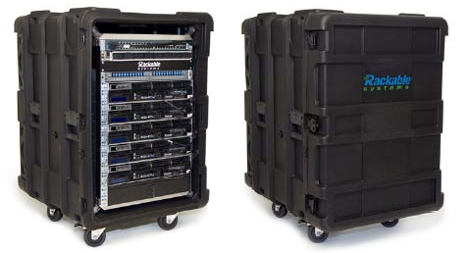
Over the past decade, “Micro-Datacenters in Container” has been developed by leading foreign manufacturers (mainly server equipment suppliers) and a number of domestic system integrators.
')
The advantages of micro-data center, many of which can be placed in a small cabinet, manufacturers also include configuration flexibility, usually understanding by this the possibility of creating a customized solution for customer requirements, the minimum production and delivery time. This is a complex product, a solution from one source: all the elements necessary for installation are included in the delivery package, which eliminates the difficulties during installation, commissioning and integration. Equipment from one manufacturer (or partners) provides a high degree of system integration. In addition, such a kit is pre-tested systems before sending to the customer.

Development trends of the world mini-data center market (according to the Marketsand Markets agency). The projected market growth is up to $ 6.3 billion in 2020. The growth rate is up to 29.8% per year. Largest markets: North America, China, India, Brazil.
Abroad this direction is considered quite promising. Allegedly, such complexes are in great demand in the West. So, given the progress in the field of the Internet of Things (IoT), micro data centers are becoming an interesting tool for processing data generated by IoT solutions. Placing a micro data center near a data source reduces transmission delays and network bandwidth requirements, which is important with the rapid increase in the number of devices connected to the network.

Border computing platforms, which can play the role of micro data centers, allow you to distribute the load and bring the computing power closer to the data source, and reduce network latency.
Micro data centers are designed to minimize capital costs, optimize the use of data center areas and energy consumption, and increase deployment speed. Several trends have led to this architecture:
Often, micro data centers are equipped with built-in uninterruptible power supplies (UPS) and infrastructure management software (DCIM). These solutions can be deployed in conventional offices as well as in more aggressive environments.

Micro and mini data centers are classified as small systems.
Typically, each of them includes the cabinet itself, as well as cooling systems, monitoring, fire suppression, power management and protection. This is a kind of autonomous data center with a high level of security and sufficient cooling capacity. And due to the light construction of such a mini-data center can be installed in places with low bearing capacity of floors.

The main elements of micro (mini) data center (according to Huawei): fire suppression, cooling, monitoring, UPS, power distribution, I / O, security.
Micro data centers can also contain: power distribution system with “intelligent” PDUs (in addition to measuring energy consumption, they can support temperature and humidity control sensors in the rack), automatic gas fire extinguishing system, access control system (ACS) and other systems (in depending on the supplier).
Execution may be different. For example, modular micro data centers from Rittal are real safes. They protect from fire, liquids, dust, burglary and corrosive gases. The safe is supplied with an air-conditioning system installed at the factory, an optional system based on inverter technology, which saves up to 40% of energy by adjusting the power according to need. If necessary, the safe can be additionally equipped with alarm systems, fire extinguishing, uninterrupted power supply, monitoring, etc.
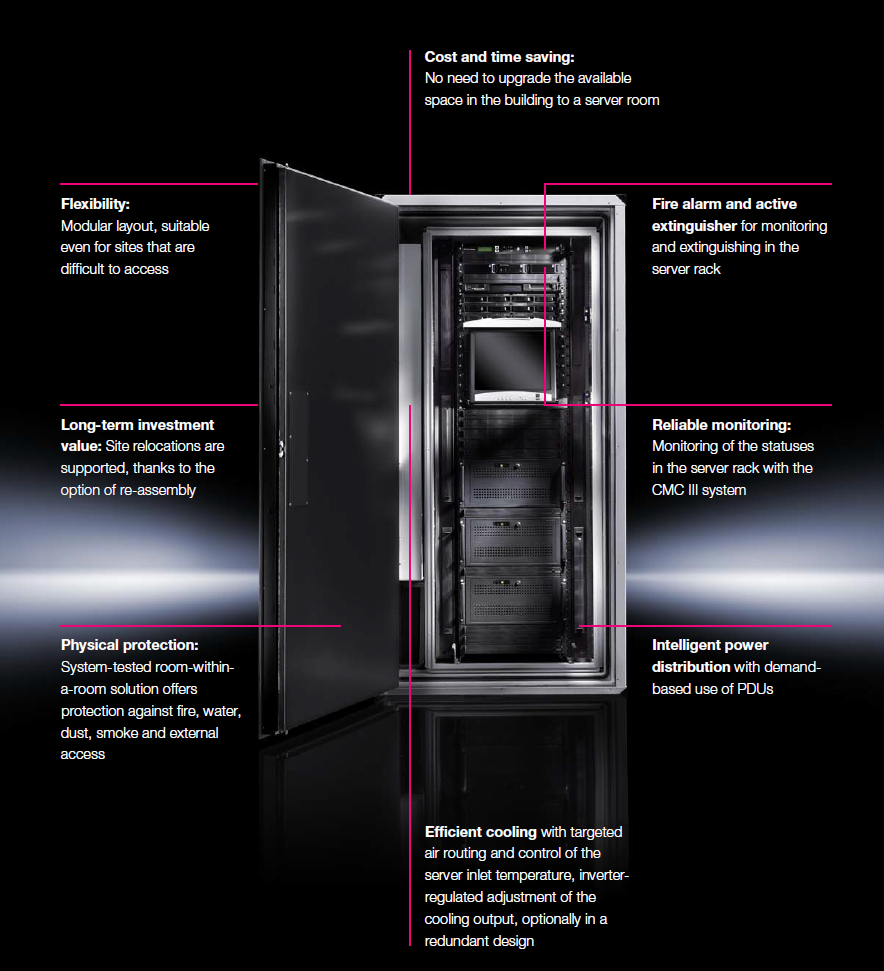
Modular micro data center from Rittal. Its advantages include the following developers:
1. Save costs and time (there is no need to equip the available space in the building to the level of the server room);
2. Flexibility (modular layout, suitable even for hard-to-reach objects).
3. Long-term investments (re-assembly and transportation options);
4. Physical protection (the solution provides protection from fire, water, dust, smoke and external access);
5. Effective cooling with well-designed routing of air flow and temperature control at the entrance to the server, adjustable inverter output power adjustment);
6. Fire alarm and active fire fighting in the server rack;
7. Reliable monitoring.
A small data center can be assembled from a series of cabinets, on the basis of which it is easy to organize a server, micro-data center for a small company, and a mini-data center for an average organization.
Since it is possible to deploy critical IT services on the basis of micro data centers, a high level of fault tolerance can be ensured, in particular, all major engineering systems (power supply, cooling) can be backed up using the N + 1 scheme (and higher). The office complex, where micro-data centers are being deployed, may not be equipped with a backup diesel generator set, so the micro-data center must provide autonomous power in case of an accident for 10-30 minutes.

A micro data center is an autonomous, secure computing system built and tested in the factory. These data centers come with all the necessary equipment for power, cooling, security and control (DCIM).
Micro data center developers apply different cooling technologies. Usually they proceed from the condition of minimizing the area occupied by the cooling system, as well as reducing the total cost of ownership and increasing energy efficiency.
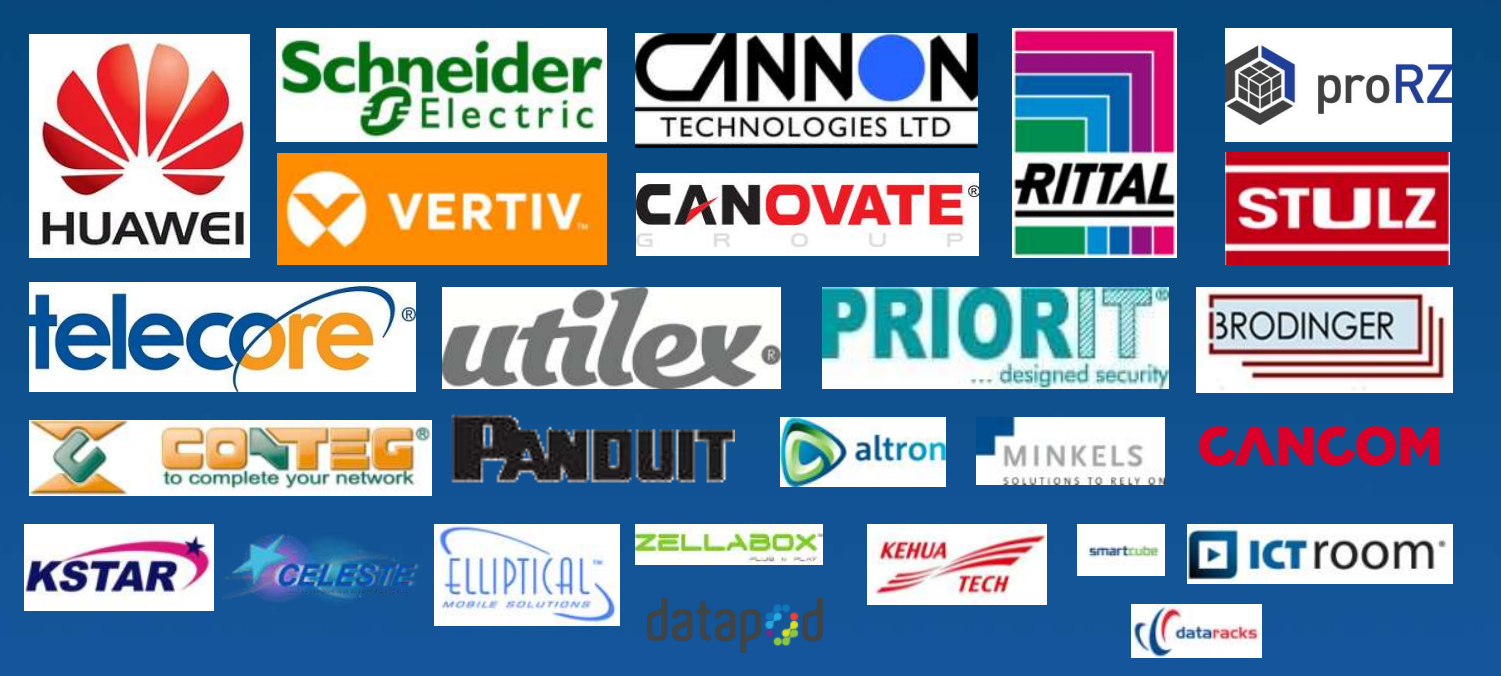
Major global manufacturers of mini and micro data centers (according to the MarketsandMarkets agency).
To make the solution structurally look like a single complex, the engineering equipment of the micro data center is usually placed in the same racks as the IT systems. It is also possible to install elements of engineering infrastructure, such as UPS, in the same racks with IT equipment. At the same time, designers seek to minimize the space occupied by engineering systems, including UPS, battery, and cooling systems.
The advantages of these solutions include scalability, compactness and energy efficiency, rapid deployment, simple management, security. This is a standardized solution, an economical solution.
An important advantage of the micro data center is the ability to deploy additional computing power in conventional offices and other sites without specialized support infrastructure. This reduces the capital costs associated with the expansion of existing data centers.
We list the main advantages of such solutions minuses (according to Huawei).
The micro data center can be delivered to the operating site with racks, UPS, power distribution, cooling and control systems pre-installed and ready for deployment.
Over the past decade, a number of interesting developments in the field of mini- and micro data centers have been presented on the Russian market.
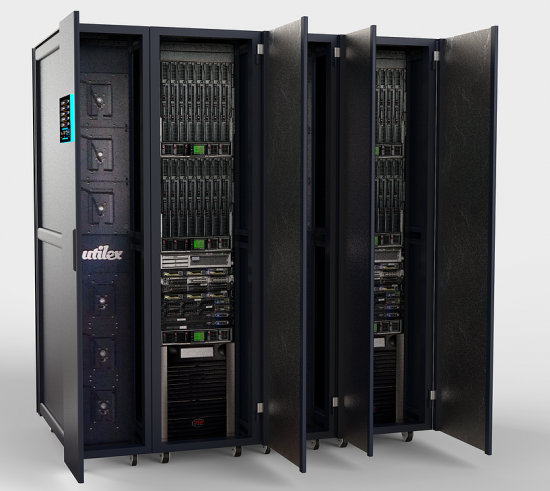
Micro-Datacenter Russian production - the development of ETegro Technologies, "Svyaz Engineering" and "Utileks."
For example, the ETegro micro data center is built on the basis of the DataStone + modular solution and combines cabinets with 19-inch racks and built-in Clever Breeze air conditioning systems manufactured by Utilex. A typical micro data center solution consists of two soundproof insulated 42U cabinets with in-line precision air conditioners located between them.
This is an enclosed, hermetic soundproofed complex with an IP65 protection class.
IT infrastructure - ETegro Hyperion servers, ETegro Fastor storage systems and ETegro Eos switches. The system uses double conversion UPS for Svyaz Engineering, the battery life is 15 minutes. The redundancy level of the system is N + 1. This solution was announced in 2015 as an efficient and cost-effective way to create a private cloud or ready-made IT infrastructure for small enterprises, branches and representative offices of geographically distributed companies. As the creators promised, the creation of a fully operational infrastructure at any point of Russia will require no more than 12 weeks.
In subsequent years, based on the experience of developing this type of micro data center, Utilex created a whole line of mini and micro data centers. These are mainly modular systems with the possibility of further expansion. Among them is DataStone Mini “supermicro-data center”, designed to accommodate any 19-inch IT equipment up to 27U and with a power up to 2.5 kW. It has a protection class of IP54, noise insulation (18 dBA), and the cooling system is based on built-in fans with anti-dust filters. There is also the possibility of installing a remote monitoring system via TCP / IP, SNMP, RS485 (Modbus RTU).

Applications DataStone Mini - replacement of server rooms, private cloud infrastructure.
The advantages of this solution, developers include savings in capital costs, short deadlines for creating a data center, high fault tolerance, the ability to move it and remote control.

Modular Micro Data Center Utilex DataStone + is designed to accommodate and ensure the required availability of computing, network equipment, storage systems, as well as any active and passive equipment. The solution with IP65 protection class has a closed cooling system (it is possible to build a cooling system with full redundancy of 2N) and supports up to 30 kW of IT load on one cabinet.
RSC Tornado Mini-Datacenter also includes all the necessary structural components: 1-2 computing racks (with Intel processors, Infiniband interconnect), cooling and power supply systems, communication subsystem, control server and display system (in the adjacent cabinet there is a pumping station, station water treatment, network equipment and storage). Such systems are deployed in Rosgidromet, MIPT. Preparation of the room for them is not required.

In the RSC Tornado architecture, liquid cooling is used for standard Intel server boards, originally designed for air-blown systems. Thanks to liquid cooling, a high energy efficiency ratio (PUE) is achieved - no more than 20% of the energy consumed is spent on cooling. Liquid cooling makes the system quieter and much more compact: the mini-data center is placed in two enclosures, occupying an area of about 2 square meters. m. Air cooling is left only for those components where the liquid is not economically feasible. A similar system with a slightly smaller number of RSC nodes was launched at RosHydroMet.

RSC company produces several lines of equipment based on its RSC Tornado complex - for micro data centers (16-64 servers), mini data centers (64-256 servers) and for large data centers on hundreds of servers.
Chinese Huawei has developed a whole line of micro and mini data centers.
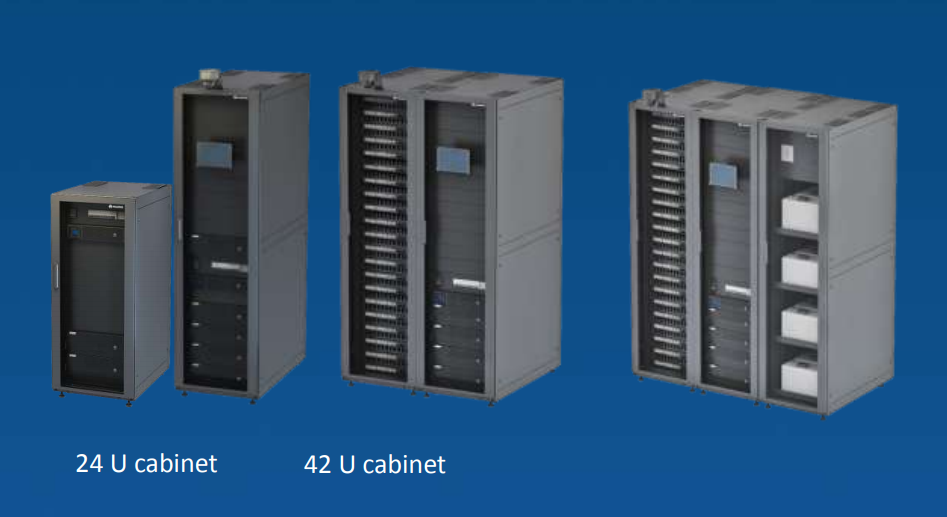
The convergent mini-data center Huawei FusionModule 500 includes 1–2 cabinets for equipment up to 4 kW per rack, UPS with redundancy designed for autonomous operation for 15–240 minutes, integrated monitoring and power distribution systems, and a remote system battery control.
For example, Huawei FusionModule 500 can be used to house equipment of small offices, organize communication nodes of remote offices, branches and representative offices, create switching centers, dispatch centers and monitoring centers, situational centers and communication centers. There is a more powerful option - Huawei FusionModule 800.
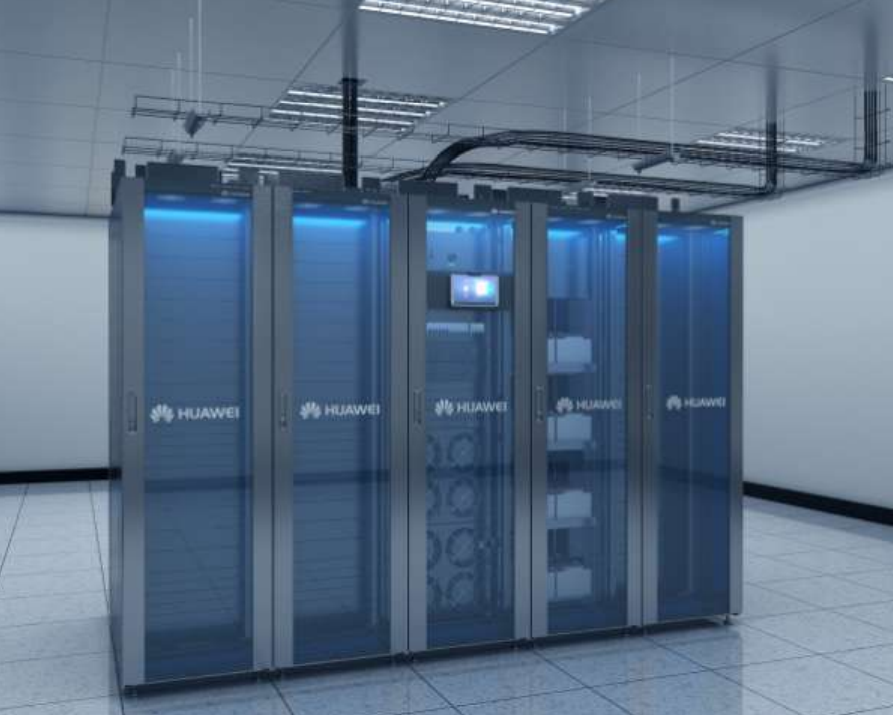
Huawei FusionModule 800 is a typical solution of 1–8 cabinets (up to 15 kW per rack) with UPS (with N + N redundancy), integrated monitoring and power distribution systems, remote battery monitoring system and air conditioning system with operation at 10% load (and N + N reservations).
Softline, in partnership with GreenMDC, offered the service “Modular Data Center as a Service” from Softline, which implies the production of a modular data center to meet customer needs, its delivery, installation and connection at the customer’s site with subsequent technical support on a monthly rental basis. The client within 4-5 months receives the ready decision. The service involves several configuration options for modular data centers from GreenMDC: from 6 to 10 cabinets and mini data centers with the number of racks from 1 to 6.

Micro Data Center Xpress line from Schneider Electric.
How tiny can a data center be? The Australian Zellabox introduced the Cubb micro data center in a 12U construct. The developers claim that this solution will interest companies that solve data migration to the cloud and companies that need to store data on their site and / or be able to temporarily “transfer” them to the cloud.
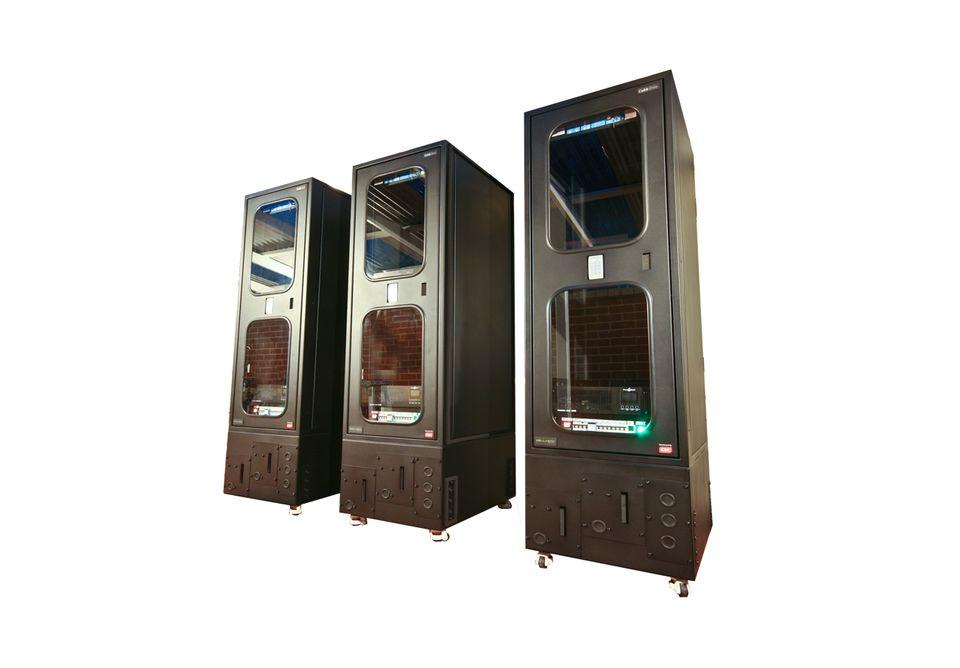
Zellabox Cubb is responsible for power, air quality and temperature. In addition, it provides security through a 24/7 monitoring system that works even in the event of a network failure. The modular solution allows you to combine several such micro data centers into a single complex.
Zellabox micro data center outperformed the Schneider Electric 23U SmartBunker and The System from Rittal by 15U in compactness.
Rittal offers compact micro datacenters with freon cooling and LCU (Liquid Cooling Unit) DX, option with freon or water cooling LCP (Liquid Cooling Package) and modular safes with all the infrastructure inside.
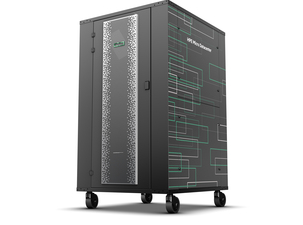
HPE Micro Datacenter is a medium density solution providing power and cooling capacity of 8 kW.
HPE Micro Datacenter provides an integrated solution with the reference software architecture Helion Cloud. It includes computing, network infrastructure, storage, management tools, DCIM. The solution is based on Schneider Electric StruxureWare. HPE OneView software provides an integrated, automated IT management environment.
The use of mini-data centers can be justified not only in small companies, there are often no professional specialists, but also in government structures and large businesses, where information is one of the most valuable assets. Typical applications for micro data centers are server room replacement, private cloud infrastructure.
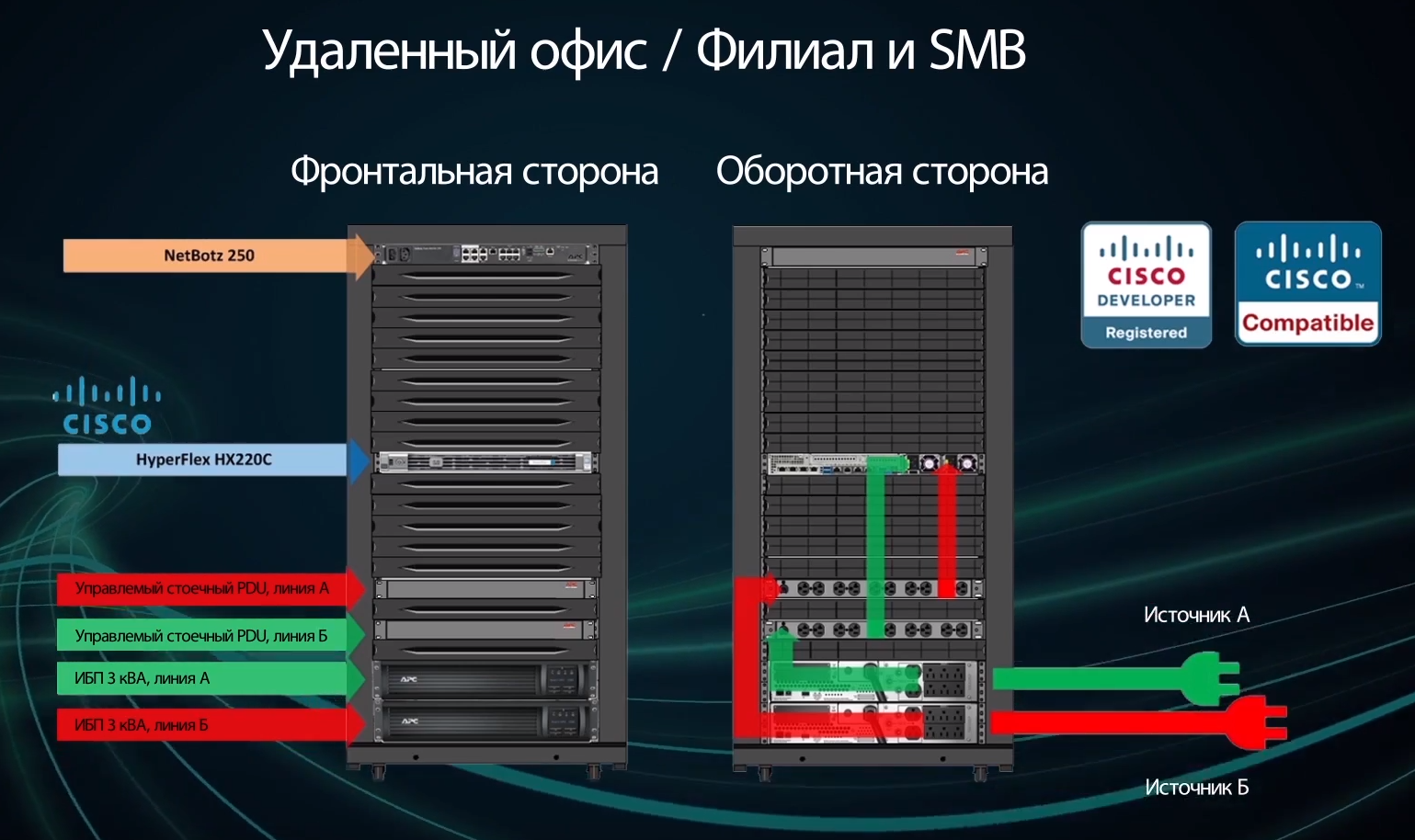

Examples of the deployment of Schneider Elecrtic micro data centers in the company's branch in SMB and in the enterprise.
There are quite unique solutions. Thus, the RSC mini-data center with liquid cooling allowed creating the Rosgidromet computing cluster, which has a low level of energy consumption in combination with a high indicator of energy efficiency and high computational efficiency.

RSC mini-data center in MIPT.
Meanwhile, the scope of the mini-data center is very wide. For example, the mini-data center Huawei FusionModule 500 was used for informatization of primary education in Xinjiang Province (PRC) - building a new information platform for learning in more than 60 educational institutions. This made it possible to quickly deploy a large number of systems before the beginning of the school year, with no locally qualified personnel.
The China Rural Credit Cooperatives Union, which has more than 3,000 branches, has implemented FusionModule 500 mini data center with centralized monitoring and control to reduce the cost of operating the system. A large supermarket chain in France provided centralized monitoring and unified management of nodes located in more than 1,500 supermarkets.

Schneider Electric's modular mini data center, custom-designed, is installed in the Sagrada Familia in Barcelona. Creating a mini-data center required minimal on-site installation, which avoided interference with visitors and construction. The microcentre of data processing meets the requirements for portability and adaptability and does not cause inconvenience to tourists, and also does not interfere with the construction and operation of the building as an active church. This micro data center received the DatacenterDynamics award.
In 2016, the company “Ulmart” built a complete center of the new format in St. Petersburg. The object with a total area of 52 000 sq. M. combines warehouse and customer service area. As part of this project, the CUBiC mini data center was installed by the specialists of the Russian company GreenMDC, designed to install one rack with power consumption up to 5 kW. CUBiC worked in the Center for the execution of orders as the main data center for three months. In the initial stages of this power was enough. Later, after the commissioning of the modular data center TelecomOutdoor NGm, auxiliary equipment is located at CUBiC, and it continues to fulfill its role as a mini-data center.
The use of mini-data centers can be justified not only in small companies, where there are often no professional specialists, but also in government structures and large business, where information is one of the most valuable assets. Many customers are interested in creating micro-data center projects. The cost of design, supply and commissioning of such a data center is comparable to the organization of the data center in the existing premises. Micro data centers can be placed in a warehouse or directly in the shop, reduce dependence on data networks from factories or from external Internet channels.


Applications of micro and mini data centers (according to Schneider Electric).
This rapidly deployable integrated solution was not destined to make a revolution in the construction of the data center: their application remained niche. Realizations of micro and mini data centers in our country are rare. However, digital information, the Internet of things and boundary computing, interest in modular convergent / hyperconvergent platforms and clouds - all this can give this direction new incentives for development.

What is a mini data center?
Micro (mini) data center is a complex consisting of one (micro data center) or several interconnected (mini data center) racks, provided with all the infrastructure necessary for the operation of IT equipment and previously assembled and tested by the manufacturer.
These data centers are mainly designed to accommodate computing power and telecommunications equipment in unprepared premises, such as offices, warehouses, utility rooms or production facilities. According to vendors, the installation time for their use is reduced to 60-70% compared with the classic solution.

Over the past decade, “Micro-Datacenters in Container” has been developed by leading foreign manufacturers (mainly server equipment suppliers) and a number of domestic system integrators.
')
The advantages of micro-data center, many of which can be placed in a small cabinet, manufacturers also include configuration flexibility, usually understanding by this the possibility of creating a customized solution for customer requirements, the minimum production and delivery time. This is a complex product, a solution from one source: all the elements necessary for installation are included in the delivery package, which eliminates the difficulties during installation, commissioning and integration. Equipment from one manufacturer (or partners) provides a high degree of system integration. In addition, such a kit is pre-tested systems before sending to the customer.
Growth drivers

Development trends of the world mini-data center market (according to the Marketsand Markets agency). The projected market growth is up to $ 6.3 billion in 2020. The growth rate is up to 29.8% per year. Largest markets: North America, China, India, Brazil.
Abroad this direction is considered quite promising. Allegedly, such complexes are in great demand in the West. So, given the progress in the field of the Internet of Things (IoT), micro data centers are becoming an interesting tool for processing data generated by IoT solutions. Placing a micro data center near a data source reduces transmission delays and network bandwidth requirements, which is important with the rapid increase in the number of devices connected to the network.

Border computing platforms, which can play the role of micro data centers, allow you to distribute the load and bring the computing power closer to the data source, and reduce network latency.
Micro data centers are designed to minimize capital costs, optimize the use of data center areas and energy consumption, and increase deployment speed. Several trends have led to this architecture:
- Increase hardware density: virtualized IT equipment in cloud architectures, which previously required 10 racks, can now fit into one.
- Convergence and integration: servers, data warehouses, network equipment and software are integrated and validated by the vendor, delivered as a turnkey solution out of the box.
- Network latency : the need to reduce latency between data centers (for example, the cloud) and applications.
- Deployment speed: reducing the deployment time of a solution sometimes provides an opportunity to gain a competitive advantage.
- Cost reduction: in many cases, micro data centers may use excess capacity that is not used for one reason or another. This underutilization is a common problem in corporate data centers.
- Cloud Services Optimization: Micro data centers play a key role in optimizing the performance and usefulness of mobile and other network devices when accessing the cloud.
How does it work?
Often, micro data centers are equipped with built-in uninterruptible power supplies (UPS) and infrastructure management software (DCIM). These solutions can be deployed in conventional offices as well as in more aggressive environments.

Micro and mini data centers are classified as small systems.
Typically, each of them includes the cabinet itself, as well as cooling systems, monitoring, fire suppression, power management and protection. This is a kind of autonomous data center with a high level of security and sufficient cooling capacity. And due to the light construction of such a mini-data center can be installed in places with low bearing capacity of floors.

The main elements of micro (mini) data center (according to Huawei): fire suppression, cooling, monitoring, UPS, power distribution, I / O, security.
Micro data centers can also contain: power distribution system with “intelligent” PDUs (in addition to measuring energy consumption, they can support temperature and humidity control sensors in the rack), automatic gas fire extinguishing system, access control system (ACS) and other systems (in depending on the supplier).
Execution may be different. For example, modular micro data centers from Rittal are real safes. They protect from fire, liquids, dust, burglary and corrosive gases. The safe is supplied with an air-conditioning system installed at the factory, an optional system based on inverter technology, which saves up to 40% of energy by adjusting the power according to need. If necessary, the safe can be additionally equipped with alarm systems, fire extinguishing, uninterrupted power supply, monitoring, etc.

Modular micro data center from Rittal. Its advantages include the following developers:
1. Save costs and time (there is no need to equip the available space in the building to the level of the server room);
2. Flexibility (modular layout, suitable even for hard-to-reach objects).
3. Long-term investments (re-assembly and transportation options);
4. Physical protection (the solution provides protection from fire, water, dust, smoke and external access);
5. Effective cooling with well-designed routing of air flow and temperature control at the entrance to the server, adjustable inverter output power adjustment);
6. Fire alarm and active fire fighting in the server rack;
7. Reliable monitoring.
A small data center can be assembled from a series of cabinets, on the basis of which it is easy to organize a server, micro-data center for a small company, and a mini-data center for an average organization.
Since it is possible to deploy critical IT services on the basis of micro data centers, a high level of fault tolerance can be ensured, in particular, all major engineering systems (power supply, cooling) can be backed up using the N + 1 scheme (and higher). The office complex, where micro-data centers are being deployed, may not be equipped with a backup diesel generator set, so the micro-data center must provide autonomous power in case of an accident for 10-30 minutes.

A micro data center is an autonomous, secure computing system built and tested in the factory. These data centers come with all the necessary equipment for power, cooling, security and control (DCIM).
Micro data center developers apply different cooling technologies. Usually they proceed from the condition of minimizing the area occupied by the cooling system, as well as reducing the total cost of ownership and increasing energy efficiency.

Major global manufacturers of mini and micro data centers (according to the MarketsandMarkets agency).
To make the solution structurally look like a single complex, the engineering equipment of the micro data center is usually placed in the same racks as the IT systems. It is also possible to install elements of engineering infrastructure, such as UPS, in the same racks with IT equipment. At the same time, designers seek to minimize the space occupied by engineering systems, including UPS, battery, and cooling systems.
Advantages and disadvantages of micro and mini data center
The advantages of these solutions include scalability, compactness and energy efficiency, rapid deployment, simple management, security. This is a standardized solution, an economical solution.
An important advantage of the micro data center is the ability to deploy additional computing power in conventional offices and other sites without specialized support infrastructure. This reduces the capital costs associated with the expansion of existing data centers.
We list the main advantages of such solutions minuses (according to Huawei).
| Virtues | disadvantages |
|---|---|
| Ability to install in unprepared premises | The need for maintenance and upkeep |
| The possibility of placing equipment in regions where the necessary data center capacity | The need for IT staff |
| Relatively low cost | Initial costs are higher than placing in a rented commercial data center |
| High deployment speed | Production and installation time is longer than switching to leased data center capacity |
| The ability to move to another site | Limited expansion options |
| Minimum footprint | Less flexibility than traditional solutions |
The micro data center can be delivered to the operating site with racks, UPS, power distribution, cooling and control systems pre-installed and ready for deployment.
Examples of solutions
Over the past decade, a number of interesting developments in the field of mini- and micro data centers have been presented on the Russian market.

Micro-Datacenter Russian production - the development of ETegro Technologies, "Svyaz Engineering" and "Utileks."
For example, the ETegro micro data center is built on the basis of the DataStone + modular solution and combines cabinets with 19-inch racks and built-in Clever Breeze air conditioning systems manufactured by Utilex. A typical micro data center solution consists of two soundproof insulated 42U cabinets with in-line precision air conditioners located between them.
This is an enclosed, hermetic soundproofed complex with an IP65 protection class.
IT infrastructure - ETegro Hyperion servers, ETegro Fastor storage systems and ETegro Eos switches. The system uses double conversion UPS for Svyaz Engineering, the battery life is 15 minutes. The redundancy level of the system is N + 1. This solution was announced in 2015 as an efficient and cost-effective way to create a private cloud or ready-made IT infrastructure for small enterprises, branches and representative offices of geographically distributed companies. As the creators promised, the creation of a fully operational infrastructure at any point of Russia will require no more than 12 weeks.
In subsequent years, based on the experience of developing this type of micro data center, Utilex created a whole line of mini and micro data centers. These are mainly modular systems with the possibility of further expansion. Among them is DataStone Mini “supermicro-data center”, designed to accommodate any 19-inch IT equipment up to 27U and with a power up to 2.5 kW. It has a protection class of IP54, noise insulation (18 dBA), and the cooling system is based on built-in fans with anti-dust filters. There is also the possibility of installing a remote monitoring system via TCP / IP, SNMP, RS485 (Modbus RTU).

Applications DataStone Mini - replacement of server rooms, private cloud infrastructure.
The advantages of this solution, developers include savings in capital costs, short deadlines for creating a data center, high fault tolerance, the ability to move it and remote control.

Modular Micro Data Center Utilex DataStone + is designed to accommodate and ensure the required availability of computing, network equipment, storage systems, as well as any active and passive equipment. The solution with IP65 protection class has a closed cooling system (it is possible to build a cooling system with full redundancy of 2N) and supports up to 30 kW of IT load on one cabinet.
RSC Tornado Mini-Datacenter also includes all the necessary structural components: 1-2 computing racks (with Intel processors, Infiniband interconnect), cooling and power supply systems, communication subsystem, control server and display system (in the adjacent cabinet there is a pumping station, station water treatment, network equipment and storage). Such systems are deployed in Rosgidromet, MIPT. Preparation of the room for them is not required.

In the RSC Tornado architecture, liquid cooling is used for standard Intel server boards, originally designed for air-blown systems. Thanks to liquid cooling, a high energy efficiency ratio (PUE) is achieved - no more than 20% of the energy consumed is spent on cooling. Liquid cooling makes the system quieter and much more compact: the mini-data center is placed in two enclosures, occupying an area of about 2 square meters. m. Air cooling is left only for those components where the liquid is not economically feasible. A similar system with a slightly smaller number of RSC nodes was launched at RosHydroMet.

RSC company produces several lines of equipment based on its RSC Tornado complex - for micro data centers (16-64 servers), mini data centers (64-256 servers) and for large data centers on hundreds of servers.
Chinese Huawei has developed a whole line of micro and mini data centers.

The convergent mini-data center Huawei FusionModule 500 includes 1–2 cabinets for equipment up to 4 kW per rack, UPS with redundancy designed for autonomous operation for 15–240 minutes, integrated monitoring and power distribution systems, and a remote system battery control.
For example, Huawei FusionModule 500 can be used to house equipment of small offices, organize communication nodes of remote offices, branches and representative offices, create switching centers, dispatch centers and monitoring centers, situational centers and communication centers. There is a more powerful option - Huawei FusionModule 800.

Huawei FusionModule 800 is a typical solution of 1–8 cabinets (up to 15 kW per rack) with UPS (with N + N redundancy), integrated monitoring and power distribution systems, remote battery monitoring system and air conditioning system with operation at 10% load (and N + N reservations).
Softline, in partnership with GreenMDC, offered the service “Modular Data Center as a Service” from Softline, which implies the production of a modular data center to meet customer needs, its delivery, installation and connection at the customer’s site with subsequent technical support on a monthly rental basis. The client within 4-5 months receives the ready decision. The service involves several configuration options for modular data centers from GreenMDC: from 6 to 10 cabinets and mini data centers with the number of racks from 1 to 6.

Micro Data Center Xpress line from Schneider Electric.
How tiny can a data center be? The Australian Zellabox introduced the Cubb micro data center in a 12U construct. The developers claim that this solution will interest companies that solve data migration to the cloud and companies that need to store data on their site and / or be able to temporarily “transfer” them to the cloud.

Zellabox Cubb is responsible for power, air quality and temperature. In addition, it provides security through a 24/7 monitoring system that works even in the event of a network failure. The modular solution allows you to combine several such micro data centers into a single complex.
Zellabox micro data center outperformed the Schneider Electric 23U SmartBunker and The System from Rittal by 15U in compactness.
Rittal offers compact micro datacenters with freon cooling and LCU (Liquid Cooling Unit) DX, option with freon or water cooling LCP (Liquid Cooling Package) and modular safes with all the infrastructure inside.

HPE Micro Datacenter is a medium density solution providing power and cooling capacity of 8 kW.
HPE Micro Datacenter provides an integrated solution with the reference software architecture Helion Cloud. It includes computing, network infrastructure, storage, management tools, DCIM. The solution is based on Schneider Electric StruxureWare. HPE OneView software provides an integrated, automated IT management environment.
Examples of using mini data center
The use of mini-data centers can be justified not only in small companies, there are often no professional specialists, but also in government structures and large businesses, where information is one of the most valuable assets. Typical applications for micro data centers are server room replacement, private cloud infrastructure.


Examples of the deployment of Schneider Elecrtic micro data centers in the company's branch in SMB and in the enterprise.
There are quite unique solutions. Thus, the RSC mini-data center with liquid cooling allowed creating the Rosgidromet computing cluster, which has a low level of energy consumption in combination with a high indicator of energy efficiency and high computational efficiency.

RSC mini-data center in MIPT.
Meanwhile, the scope of the mini-data center is very wide. For example, the mini-data center Huawei FusionModule 500 was used for informatization of primary education in Xinjiang Province (PRC) - building a new information platform for learning in more than 60 educational institutions. This made it possible to quickly deploy a large number of systems before the beginning of the school year, with no locally qualified personnel.
The China Rural Credit Cooperatives Union, which has more than 3,000 branches, has implemented FusionModule 500 mini data center with centralized monitoring and control to reduce the cost of operating the system. A large supermarket chain in France provided centralized monitoring and unified management of nodes located in more than 1,500 supermarkets.

Schneider Electric's modular mini data center, custom-designed, is installed in the Sagrada Familia in Barcelona. Creating a mini-data center required minimal on-site installation, which avoided interference with visitors and construction. The microcentre of data processing meets the requirements for portability and adaptability and does not cause inconvenience to tourists, and also does not interfere with the construction and operation of the building as an active church. This micro data center received the DatacenterDynamics award.
In 2016, the company “Ulmart” built a complete center of the new format in St. Petersburg. The object with a total area of 52 000 sq. M. combines warehouse and customer service area. As part of this project, the CUBiC mini data center was installed by the specialists of the Russian company GreenMDC, designed to install one rack with power consumption up to 5 kW. CUBiC worked in the Center for the execution of orders as the main data center for three months. In the initial stages of this power was enough. Later, after the commissioning of the modular data center TelecomOutdoor NGm, auxiliary equipment is located at CUBiC, and it continues to fulfill its role as a mini-data center.
Who needs it?
The use of mini-data centers can be justified not only in small companies, where there are often no professional specialists, but also in government structures and large business, where information is one of the most valuable assets. Many customers are interested in creating micro-data center projects. The cost of design, supply and commissioning of such a data center is comparable to the organization of the data center in the existing premises. Micro data centers can be placed in a warehouse or directly in the shop, reduce dependence on data networks from factories or from external Internet channels.


Applications of micro and mini data centers (according to Schneider Electric).
This rapidly deployable integrated solution was not destined to make a revolution in the construction of the data center: their application remained niche. Realizations of micro and mini data centers in our country are rare. However, digital information, the Internet of things and boundary computing, interest in modular convergent / hyperconvergent platforms and clouds - all this can give this direction new incentives for development.
Source: https://habr.com/ru/post/352746/
All Articles